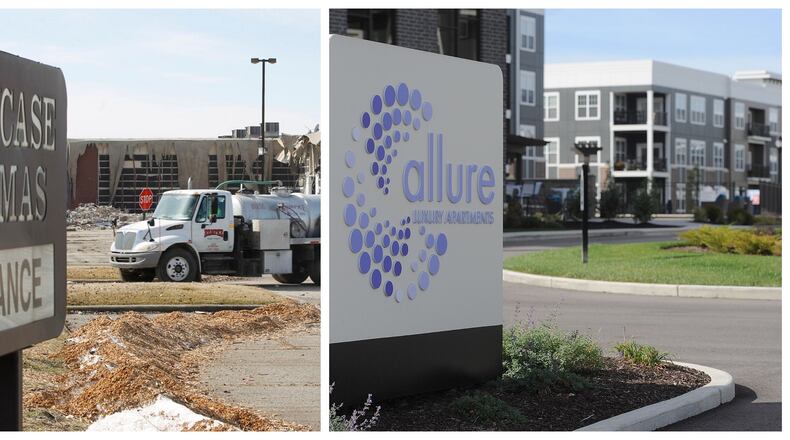• At the former Marian Meadows shopping center in Huber Heights, construction on a $40 million redevelopment project is set to begin this fall. Plans include a new senior center and two new housing complexes, one for families and one for seniors, and potentially a new city administration building.
• The former Salem Mall in Trotwood was demolished in 2006 and the property still sits empty. Trotwood’s Community Improvement Corporation launched a first step last year, with plans to transform the vacant Sears building into a business hub.
• The former Showcase Cinemas site in Centerville also closed in 2006. It took awhile, but the first residents moved into the $30-plus million Allure apartments on that site in 2019, with 312 luxury units now open in seven buildings.
Sites go vacant or mostly vacant for many reasons, but preventing them from turning into decades-long eyesores is a key to spurring redevelopment and economic growth. Even the giant GM Moraine plant got a partial repurposing from Fuyao Glass within six years.
Key reasons and adjustments
The coronavirus pandemic played a role in Kettering’s loss of Synchrony Financial, which housed 1,900 jobs at Kettering Business Park on Wilmington Pike, City Manager Mark Schwieterman said.
The city had a big win in the same complex with Amazon’s last-mile delivery center in 2019. But they’re now looking to fill two 200,000 square-foot buildings left vacant more than a year ago as part of Synchrony’s global work-from-home strategy.
That decision “gave us an inkling that this option would forever be part of our economic development plans. Remote work lessens the demand for office space,” Schwieterman said. “There are fewer prospects looking for large square footage in office space; but, as more companies return to the office for collaboration, we are confident that we will see new opportunities.”
In Huber Heights, location played a key role in redevelopment of the Marian Meadows site at Brandt Pike and Fishburg Road.
“(Marian Meadows) is across the street from some of our more frequented commercial and retail establishments and it sees a lot of traffic around it, so ... it stands out relative to the facilities around it,” said interim city manager Bryan Chodkowski. “If you have one vacant warehouse that’s in an industrial neighborhood, it’s not going to stand out to a lot of people and doesn’t seem out of character.”
Other determinants of success can include structural or environmental issues with a vacant property, Chodkowski said, especially when it comes to decades-old facilities.
In Trotwood, Community Improvement Corporation Director Chad Downing said financing is a big factor for potential success at the Salem Mall site, to make the project worth a developer’s consideration.
The city of Trotwood used Tax Increment Financing to hasten the mall’s 2006 demolition. However, Downing said redevelopment plans floundered during the Great Recession in the late 2000s, leaving the city on the hook to repay the TIF and making the same financing tool unattainable for the site’s current redevelopment.
The Sears building project — aiming for a local produce market, an entrepreneurship service center and workforce programs — was recently awarded $2 million in Congressional Project Funding toward the estimated $16 million cost. But that’s just one step.
“One of the hurdles has been, how do we work with developers to overcome that we can’t use a TIF or CRA tax abatement to help them and make the numbers look better so that developers will choose to come here?” Downing said.
A developer’s view in Xenia’s center city
Dillin Corp, the developer of Austin Landing, is helping the city of Xenia tackle the revitalization of Xenia Towne Square, a 15.5-acre property that’s in the heart of downtown and struggling with vacancy.
After months of planning and major public input, the plan includes a central public plaza and between 25 and 30 townhomes on the south side of Church Street. Dillin plans to reinstall the pre-1970s pedestrian street grid, with space for retail, restaurants, public events, market-rate apartments, and office space.
“What we’re working on is to go back and reinvent what was there before 1974,” CEO Larry Dillin said, referring to that year’s destructive tornado. “We look not just at the borders of the project, we look beyond that into the surrounding neighborhoods. We try to get an understanding of what the fabric of the community is, and when we create our development solution, we knit the fabric together so it ends up stronger than when we found it.”
After the tornado, Xenia Towne Square was developed as a retail center, which were popular at the time. Originally built to help the city recover, the strip mall-style spot has outlived its useful life, Dillin said.
Scores of new development projects are being hamstrung by rising inflation and construction costs, in some cases delaying cities’ efforts to bring in new business.
“Real estate development is a little more complex today than it was a year ago,” Dillin said. “In today’s environment, it’s very difficult to get construction cost quotes that are valid for even 30 days, let alone two years. The same goes for interest rates. If you create a vision, and people stay committed to that vision, you can weather those bumps in the road.”
Development projects like Xenia Towne Square are often multi-phased and play out over many years, Dillin said.
“It’s creating a vision and making sure there’s a key stakeholder group that owns the vision,” he said. “Then together, we make decisions over the long haul to implement that vision, and we’ll make it a sustainable project by doing that. It’s a marathon, not a sprint.”
Centerville’s long game toward success
The Allure project on Loop Road showed how long success can take. The Showcase Cinema closed in 2006, sat empty and was demolished in 2013-14. The Allure project was approved by city council in 2017, with the first residents coming in 2019, and the project reaching completion in 2021.
Three miles south on Ohio 48, a $10 million Kettering Health physician office building is replacing the former Kroger store that was vacated in 2011. The health care provider will occupy 66,000 square feet of the 15.2-acre Centerville Place site and “the city is hopeful future phases will include redevelopment of the remaining commercial spaces,” according to Centerville Development Director Michael Norton-Smith.
The city is also planning an $11 million Uptown redevelopment, which is less about replacing large vacancies but still a multi-year makeover of the town’s historic center, which includes a 113-acre entertainment district.
The state-approved designation provides more liquor licenses and has helped attract new restaurants and businesses near the intersection of Ohio 725 and Ohio 48, city officials said. They include the Brunch Pub and Manna, an upscale establishment operated by the co-owner of the Oregon District’s Salar Restaurant and Lounge.
Kettering’s continuing efforts to revitalize
The former Synchrony site may have new ownership soon after zoning changes that allow a broader range of businesses. Cleveland-based Industrial Commercial Properties is under contract to buy the 950 Forrer Blvd. land and would like to close the deal this spring, said Dean Miller, its senior vice president of leasing and acquisitions.
Miller said ICP envisions attracting businesses that would “likely be a mix, smaller than Synchrony.” The 36.5-acre site now owned by F1 Kettering LLC of California accounts for nearly one third of the 120-acre business park.
ICP also owns several buildings at Miami Valley Research Park, the largest of which is at 1900 Founders Drive near Beavercreek and Riverside, officials said. As with the Salem Mall, financing matters here — the vacant Founders site has received city, JobsOhio and Dayton Development Coalition financial aid.
And just like in Huber Heights, location counts too. A JobsOhio executive has called it “a premier site” for military contractors of Wright-Patterson Air Force Base and “ideal for innovative companies that are looking to grow.”
Also on the city’s radar is the Wilmington Heights Shopping Center, a 37,822 square-foot site on busy Wilmington Pike that has sat largely empty for years. Relationships with property owners matter, too. City officials have not been in the building to assess its condition, Schwieterman said.
“The city has limited ability to redevelop the site, but we would welcome conversations with the owner,” he added.






